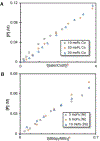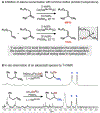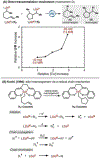Mechanistic Interrogation of Co/Ni-Dual Catalyzed Hydroarylation
- PMID: 30153002
- PMCID: PMC6329606
- DOI: 10.1021/jacs.8b06458
Mechanistic Interrogation of Co/Ni-Dual Catalyzed Hydroarylation
Abstract
Cobalt/nickel-dual catalyzed hydroarylation of terminal olefins with iodoarenes builds complexity from readily available starting materials, with a high preference for the Markovnikov (branched) product. Here, we advance a mechanistic model of this reaction through the use of reaction progress kinetic analysis (RPKA), radical clock experiments, and stoichiometric studies. Through exclusion of competing hypotheses, we conclude that the reaction proceeds through an unprecedented alkylcobalt to nickel direct transmetalation. Demonstration of catalytic alkene prefunctionalization, via spectroscopic observation of an organocobalt species, distinguishes this Csp2-Csp3 cross-coupling method from a conventional transmetalation process, which employs a stoichiometric organometallic nucleophile, and from a bimetallic oxidative addition of an organohalide across nickel, described by radical scission and subsequent alkyl radical capture at a second nickel center. A refined understanding of the reaction leads to an optimized hydroarylation procedure that excludes exogenous oxidant, demonstrating that the transmetalation is net redox neutral. Catalytic alkene prefunctionalization by cobalt and engagement with nickel catalytic cycles through direct transmetalation provides a new platform to merge these two rich areas of chemistry in preparatively useful ways.
Figures


















Similar articles
-
Single-Electron Transmetalation via Photoredox/Nickel Dual Catalysis: Unlocking a New Paradigm for sp(3)-sp(2) Cross-Coupling.Acc Chem Res. 2016 Jul 19;49(7):1429-39. doi: 10.1021/acs.accounts.6b00214. Epub 2016 Jul 5. Acc Chem Res. 2016. PMID: 27379472 Free PMC article.
-
NiH-Catalyzed Functionalization of Remote and Proximal Olefins: New Reactions and Innovative Strategies.Acc Chem Res. 2022 Dec 6;55(23):3519-3536. doi: 10.1021/acs.accounts.2c00628. Epub 2022 Nov 9. Acc Chem Res. 2022. PMID: 36350093
-
Synthetic and Mechanistic Implications of Chlorine Photoelimination in Nickel/Photoredox C(sp3)-H Cross-Coupling.Acc Chem Res. 2021 Feb 16;54(4):988-1000. doi: 10.1021/acs.accounts.0c00694. Epub 2021 Jan 29. Acc Chem Res. 2021. PMID: 33511841 Free PMC article.
-
Nickel and cobalt-catalyzed coupling of alkyl halides with alkenes via heck reactions and radical conjugate addition.Mini Rev Med Chem. 2013 May 1;13(6):802-13. doi: 10.2174/1389557511313060003. Mini Rev Med Chem. 2013. PMID: 23544460 Review.
-
Ni-Catalyzed C-C Couplings Using Alkyl Electrophiles.Top Curr Chem (Cham). 2016 Oct;374(5):66. doi: 10.1007/s41061-016-0067-6. Epub 2016 Aug 31. Top Curr Chem (Cham). 2016. PMID: 27580894 Review.
Cited by
-
Titanium and Cobalt Bimetallic Radical Redox Relay for the Isomerization of N-Bz Aziridines to Allylic Amides.Synthesis (Stuttg). 2021;53(22):4213-4220. doi: 10.1055/s-0037-1610779. Epub 2021 Jul 29. Synthesis (Stuttg). 2021. PMID: 34764520 Free PMC article.
-
Roles of Iron Complexes in Catalytic Radical Alkene Cross-Coupling: A Computational and Mechanistic Study.J Am Chem Soc. 2019 May 8;141(18):7473-7485. doi: 10.1021/jacs.9b02117. Epub 2019 Apr 26. J Am Chem Soc. 2019. PMID: 31025567 Free PMC article.
-
Directed Markovnikov hydroarylation and hydroalkenylation of alkenes under nickel catalysis.Chem Sci. 2021 Jul 13;12(33):11038-11044. doi: 10.1039/d1sc03121j. eCollection 2021 Aug 25. Chem Sci. 2021. PMID: 34522301 Free PMC article.
-
Harnessing the potential of acyl triazoles in bifunctional cobalt-catalyzed radical cross-coupling reactions.Nat Commun. 2024 Aug 13;15(1):6965. doi: 10.1038/s41467-024-51376-9. Nat Commun. 2024. PMID: 39138198 Free PMC article.
-
Iron-Catalyzed Hydrobenzylation: Stereoselective Synthesis of (-)-Eugenial C.J Am Chem Soc. 2023 Jul 26;145(29):15714-15720. doi: 10.1021/jacs.3c05428. Epub 2023 Jul 12. J Am Chem Soc. 2023. PMID: 37437221 Free PMC article.
References
-
- Miyaura N; Suzuki A Chem. Rev 1995, 95, 2457–2483.
-
- For seminal reports on dual-catalytic transmetalations, see Cu/Pd: (a) Sonogashira K; Tohda Y; Hagihara N Tetrahedron Lett 1975, 16, 4467–4470.
- Gooßen LJ; Deng G; Levy LM Science 2006, 313, 662–664. Cu/Ni: - PubMed
- Semba K; Ohtagaki Y; Nakao Y Org. Lett 2016, 18, 3956–3959. Pd/Ni: - PubMed
- Ackerman LKG; Lovell MM; Weix DJ Nature 2015, 524, 454–457. Rh/Pd: - PMC - PubMed
- Sawamura M; Sudoh M; Ito YJ Am. Chem. Soc 1996, 118, 3309–3310. Au/Pd:
- Shi Y; Roth KE; Ramgren SD; Blum SA J. Am. Chem. Soc. 2009, 131, 18022–18023. - PubMed
- García-Dominguez P; Nevado CJ Am. Chem. Soc 2016, 138, 3266–3269. Fe/Pd: - PubMed
- Chen B; Ma S Chem. - Eur. J 2011, 17, 754–757. Ni/Cr: - PubMed
- Fürstner A; Shi NJ Am. Chem. Soc 1996, 118, 2533–2534. V/Pd:
- Trost BM; Luan XJ Am. Chem. Soc 2011, 133, 1706–1709. - PubMed
-
- Green SA; Matos JLM; Yagi A; Shenvi RA J. Am. Chem. Soc 2016, 138, 12779–12782. - PubMed
-
- (a) Iwasaki K; Wan KK; Oppedisano A; Crossley SWM; Shenvi RA J. Am. Chem. Soc 2014, 136, 1300–1303. - PMC - PubMed
- Crossley SWM; Martinez RM; Guevera-Zuluaga S; Shenvi RA Org. Lett 2016, 18, 2620–2623. - PMC - PubMed
- Obradors C; Martinez RM; Shenvi RA J. Am. Chem. Soc 2016, 138, 4962–4971. - PMC - PubMed
- Crossley SWM; Barabe,´ F.; Shenvi, R. A. J. Am. Chem. Soc 2014, 136, 16788–16791. - PMC - PubMed
Publication types
MeSH terms
Substances
Grants and funding
LinkOut - more resources
Full Text Sources
Other Literature Sources

